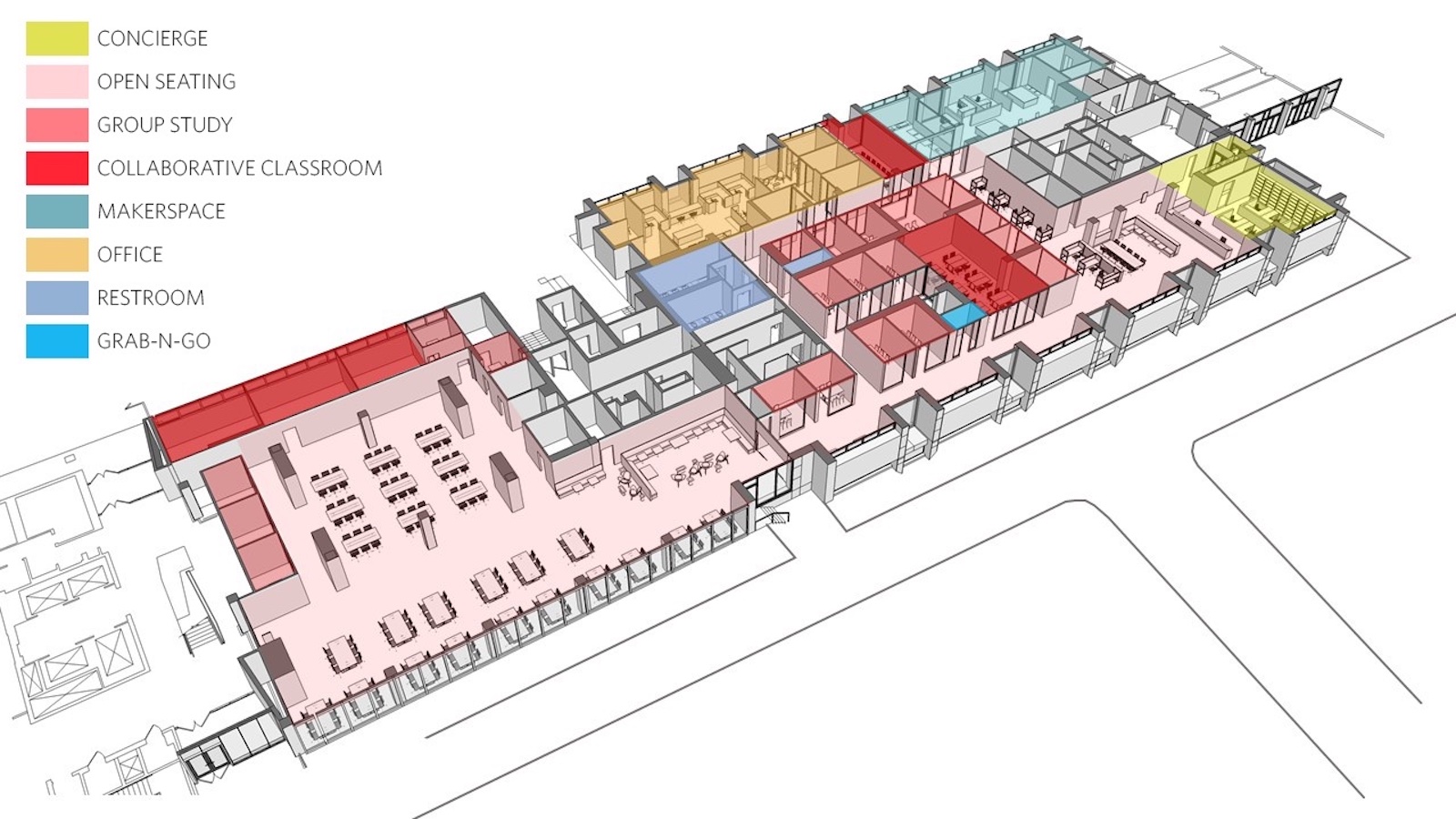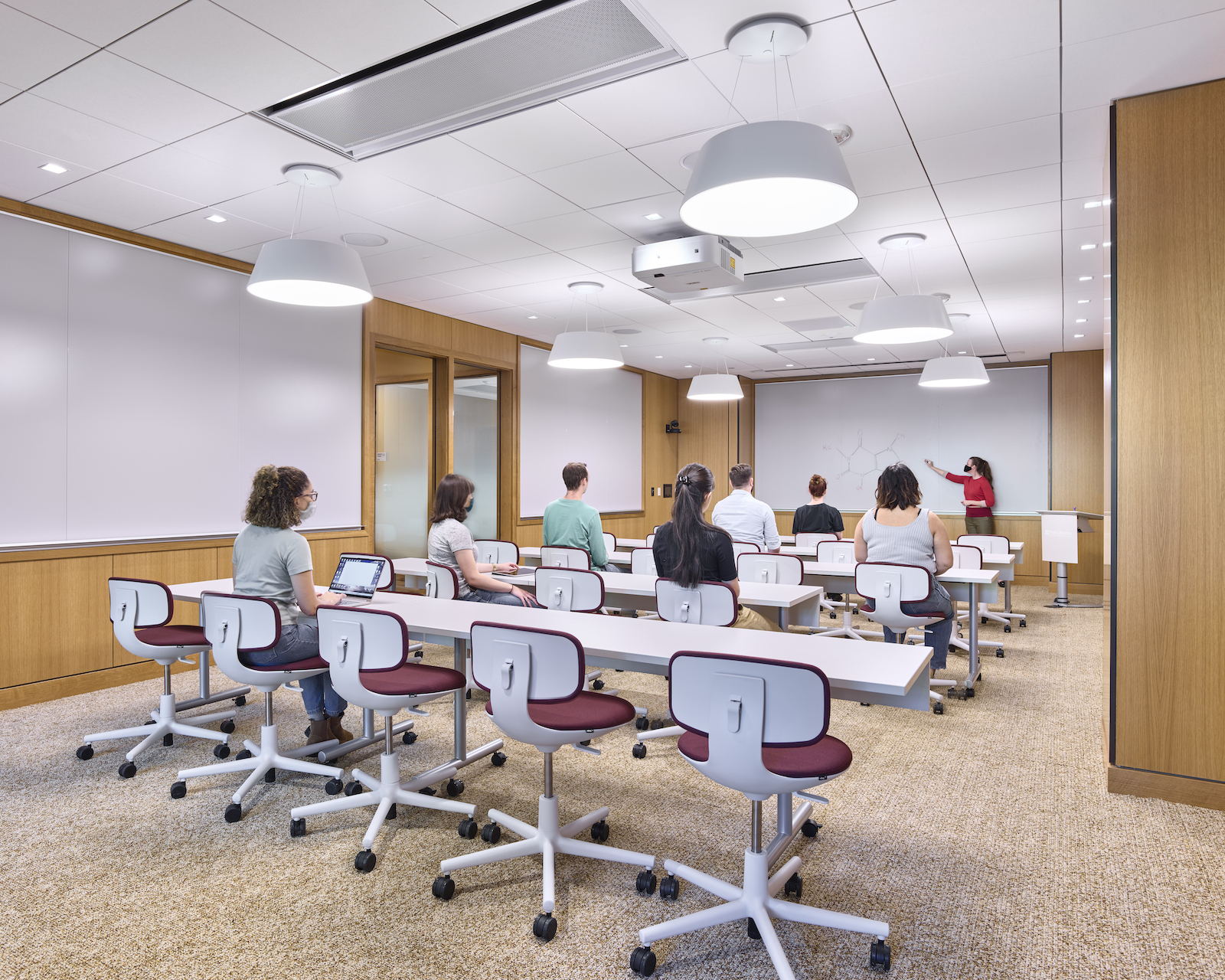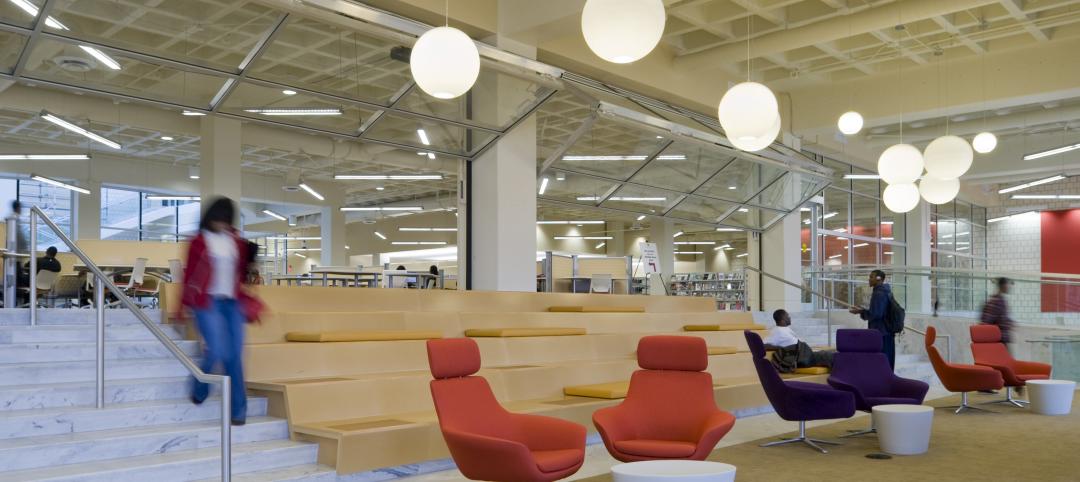The University of Pennsylvania’s Biomedical Library was built on the southern portion of the school’s campus in Philadelphia in the late 1960s. Much has changed in the ensuing decades: Penn has expanded and transformed that part of its campus with research and clinically focused buildings. And digitization has altered the function and purpose of libraries in general to where they are less about being repositories of past knowledge and more about contributing to a dynamic future.
On September 20, 2021, Penn reopened its renovated and expanded library as an open center for cross-disciplinary learning, prototyping, and collaboration. Now called Biotech Commons, the 17,000-sf building supports new modes of research by offering a range of spaces and services—from conference centers to fabrication shops—that is free to be scheduled by any student or faculty member.
“No place is as interdisciplinary as a library space, and the reimagined Biotech Commons takes this to the next level,” Constantia Constantinou, the H. Carton Rogers III Vice Provost and Director of the Penn Libraries, told Penn Today. She predicted that the facility “will enhance the intellectual vitality of Penn as a whole by providing an extraordinary user experience for all.”
The Biotech Commons unites the medical and scientific campus to the north and the core campus to the south, said the university in a statement it sent to BD+C in early January. “It is intended to provide a high-tech, community-building hub that integrates resources and brings together students, faculty, researchers, and staff from multiple disciplines.” The Biotech Commons also serves as “a powerful magnet” for communities from across campus.

“The facility is very clearly research oriented, and the research is more technologically advanced,” observes Daniela Voith, FAIA, LEED AP BD+C, IIDA, Founding Partner and Director of Design with Voith & Mactavish Architects (VMA), the design architect on the Biotech Commons renovation, which began in December 2020. Voith says that Associate Principal Sennah Loftus, VMA’s project manager, is this firm’s go-to person when it comes to integrating high-level technology into its academic facility designs.
The Judith and William Bollinger Digital Fabrication Lab within Biotech Commons is equipped with nine high-end 3D printers and two 3D scanners, a laser cutter, and plotters for scientific poster printing. The first-of-its-kind anatomy visualization system, called an Anatomage Table, is available for use by all members of the Penn community, allowing for the virtual dissection and review of life-size virtual cadavers outside of clinical lab coursework.
At the heart of Biotech Commons are clusters of adaptable group workspaces. Accommodating anywhere from four to 12 people, these allow students to have impromptu breakout sessions and meetings. A spacious, natural-light-filled reading room offers places for individual study. Various seating options encourage different formats of collaboration, and 20 group study rooms accommodate eight people each. The group studies are acoustically treated, allowing students to work together freely without disrupting others.
The reading room doubles as a multipurpose event space with moveable furniture; a Design Thinking Studio has wall-mounted whiteboards, supplies, and mobile, writable tables; and a Mixed Reality Lab is where faculty and students experiment with virtual and augmented reality. A conference room showcases the libraries’ historic collections. And the flexibly furnished Gershwind & Bennett Family Collaboration Classroom hosts seminars, lecture-style presentations, and active, flipped-classroom style instruction.
Most of the books in the library remained in the stacks on the lower levels, which were outside the renovation area.
Bureaucratic Stalling at the university level
The building team on this $11.5 million project included Wolfe Scott Associates (CM), Burns Engineering, and KMK Consulting (AV/IT). Voith says that about half of what is now Biotech Commons was renovated, and the other half had been used previously as shelf space for Stemmler Hall of the university’s Perelman School of Medicine. The library’s renovation had to be planned around sensitive lab space that included a basement which hosts Zebrafish aquariums with very low tolerances for sound vibration.

Before VMA came on board for this project, Penn Libraries—that oversees a network of 17 campus buildings—had conducted a feasibility study for the Biomedical Library renovation. VMA proposed several changes, including a new main entrance. Several master plans were bandied about to give the medical school, which is part of this complex, a better entrance, too. However, these changes would have put the project between $5 million and $6 million over budget, says Voith. It took another year to come up with an alternative plan that everyone agreed on.
Related Stories
| May 9, 2012
Shepley Bulfinch given IIDA Design award for Woodruff Library?
The design challenges included creating an entry sequence to orient patrons and highlight services; establishing a sense of identity visible from the exterior; and providing a flexible extended-hours access for part of the learning commons.
| May 8, 2012
Morgan/Harbour completes three projects at Columbia Centre
Projects completed on behalf of property owner, White Oak Realty Partners, LLC, Pearlmark Realty Partners, LLC and Angelo Gordon & Co.
| May 7, 2012
2012 BUILDING TEAM AWARDS: TD Ameritrade Park
The new stadium for the College World Series in Omaha combines big-league amenities within a traditional minor league atmosphere.
| May 3, 2012
2012 BUILDING TEAM AWARDS: Rush University Medical Center
This fully integrated Building Team opted for a multi-prime contracting strategy to keep construction going on Chicago’s Rush University Medical Center, despite the economic meltdown.
| May 3, 2012
U of Michigan team looking to create highly efficient building envelope designs
The system combines the use of sensors, novel construction materials, and utility control software in an effort to create technology capable of reducing a building’s carbon footprint.
| May 2, 2012
Building Team completes two additions at UCLA
New student housing buildings are part of UCLA’s Northwest Campus Student Housing In-Fill Project.
| May 1, 2012
Construction is underway on MLK ambulatory care center in L.A.
Featuring a variety of sustainable features, the new facility is designed to achieve LEED Gold Certification.
| Apr 30, 2012
Virginia Commonwealth unveils design for Arts Institution
Institute for Contemporary Art will serve as a catalyst for exhibitions, programs, research and collaboration.
| Apr 25, 2012
J.C. Anderson selected for 50,000-sf build out at Chicago’s DePaul University
The build-out will consist of the construction of new offices, meeting rooms, video rooms and a state-of-the-art multi-tiered Trading Room.
| Apr 17, 2012
Princeton Review releases “Guide to 322 Green Colleges”
The guide profiles 322 institutions of higher education in the U.S. and Canada that demonstrate notable commitments to sustainability in their academic offerings, campus infrastructure, activities and career preparation.
















